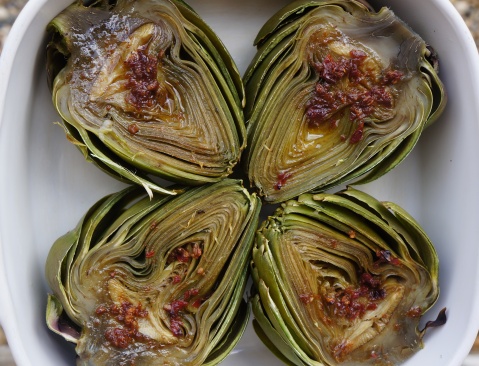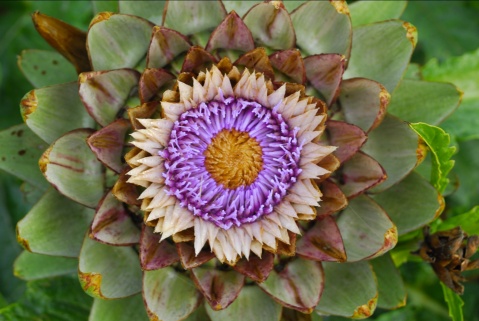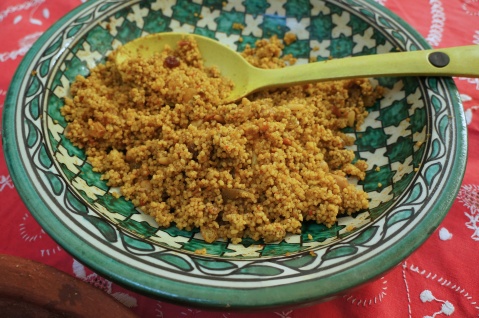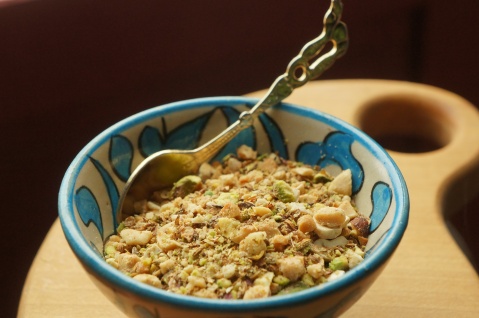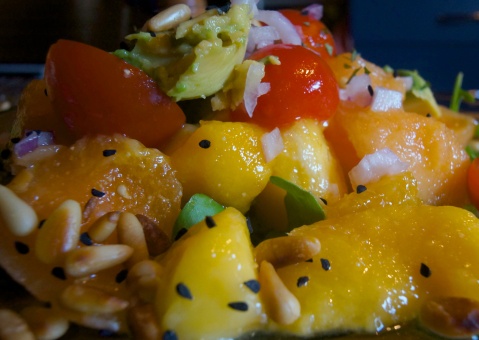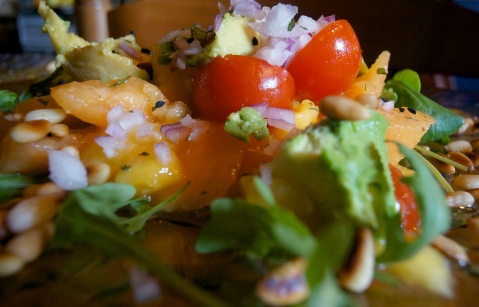Welcome to the year of the Fire Monkey!
I am the seasoned traveler
Of the Labyrinth.
The genius of alacrity,
Wizard of the impossible.
My brilliance is yet unmatched
In its originality.
My heart’s filled with potent magic
That could cast a hundred spells. I am put together
For mine own pleasure
I AM THE MONKEY.

The Chinese New Year of the Fire Monkey will start today – February 8, 2016 – the second New Moon after the Winter Solstice. Of the five Taoist elements Fire, Earth, Metal, Water, and Wood, this is the year of the red Fire Monkey. Red means go! Fire brings passion, creativity and joy. Fire types are strong, dynamic, and can overcome illness and obstacles. Following 12 months of the dignified and surefooted Sheep (or Goat or Ram), the New Year of the Red Monkey is going to shake, rattle and roll!
Monkey See ~ Monkey Do!

The year of the Monkey is ideal for a quantum leap in your life! Now is the time to shake things up, create change, and imagine a new path! This Monkey year will bring an enthusiastic energy for change – when risks are rewarded and anything can happen. Even the most ambitious plans can succeed. There will be more than enough action and opportunity to keep you busy. In Monkey year, it’s just fine to make it up as you go along – but don’t be gullible and trust the wrong people, or wily Monkey will take all the peanuts and leave you only shells!
Monkey Business!
All of the 12 animals of the Chinese Zodiac have a shadow side, and the Monkey is no exception. The Monkey is commonly regarded as the emblem of trickery, so be on the alert for deceptions. It’s innovative problem-solving tendencies can turn the Monkey into being a tricky tactician, opportunistic and not all that trustworthy. Youthfulness hides an unscrupulous adolescent, and independence can turn to unfaithfulness. Talk is fast and cheap and the Monkey type will want to work the shrewdest angle, get the best deal, and win big.
 Monkey Madness ~ Monkey Mind!
Monkey Madness ~ Monkey Mind!
Be aware not to jump ahead of yourself this year, and try to calm what is called “Monkey-mind” in Buddhism: jump to a branch, grab a banana, peel it, take a bite, drop it. Then jump to the next branch, grab a banana, peel it, take a bite, and drop it… in a never ending tail-chasing cycle of uselessness. As soon as you realize that a path is not fruitful, take a risk and try a new one instead of staying stuck in old ways that are familiar but don’t work. Easier said than done, n’est ce pas? But daring to be different can lead to success.
Be a Cheeky Monkey!
The Year of the Monkey 2016 is a good year to break free and take calculated risks as there is nothing more powerful or rewarding than following your heart’s desire. Run with ideas, embrace the inventive, and don’t look back! Now is the time of courage, action, anarchy, and true devotion to even the wildest of schemes, it’s time to start new endeavors, for they are destined to succeed under Monkey’s influence.

Go for it you cheeky monkey!
Sensational Seasonal Sale!

Sensational savings this Festive Season in 3 easy steps!
25% discount off all treatments and B&B booked before December 25th!

1. Pay a deposit with your booking before 25th December 2015
2. Receive an Xmas gift voucher to pop under the tree.
3. Redeem your voucher between January – June 2016.
What could be simpler?
Under The Lime Tree ~ The Place for a Christmas Pressie!

Contact me by email to start the savings process!
Meat Free Mondays! Grilled Globe Artichokes with a garlic & chili dresssing

Grilled Globe Artichokes with a garlic & chili dressing
Our garden is resplendent with globe artichokes reaching out in all directions to fill up, if not choke, the skyline at the back of the house. They’re wonderful to watch ~ the heads, or globes, blooming and opening every time you turn your back, and then all of a sudden, you’ve lost the chance to harvest them! No matter, they become the most marvelous flowers and continue to bewitch insect wildlife for weeks to come.
Lots of people don’t know what to do with fresh artichoke globes but when in season, they’re one of the simplest and easiest vegetables to add to your diet, and in terms of their benefits, they’re great for assisting digestion and liver function.
Have ready 1 globe or head per person and a large pan of boiling water. Cut the globes in half, tip to stem. Plunge them immediately into the water and boil vigorously for 15 minutes. Meanwhile, make the dressing.
50 gms of butter melted; 3 garlic cloves, crushed; 1 red chili, finely chopped (remove seeds and pith if you want to lessen the strength of hotness); salt to season
Toss the garlic and chili into the melted butter and fry together for a minute or two. Set aside. When the globes are ready drain well. Place cut side up in a baking tray and pop under a hot grill for 2 minutes. Take out, spoon the butter, garlic and chili dressing over the heads and pop back under the grill for another minute. Serve immediately. Good as an appetizer or a starter.
The heart of the globe is the fleshiest and tastiest part, but each leaf has some flesh on it, so drag it off between your teeth then discard the rest of the leaf ~ very primitive and good fun! You don’t have to cut the globe head in half before cooking, but doing so simply reduces cooking time and makes for a great display. You can have any dressing too. Something buttery and piquant work well to bring out the flavours of the flesh.
Bon Appétit!
Copies of Nikki’s recipe book are available from Amazon or signed from Under The Lime Tree
Meat Free Mondays ~ Salt : Saviour or Sinner?
“Salt is what makes things taste bad when it isn’t in them.” – Unknown
I though this article was fascinating, so I’ve pinched and copied it here… Feels like there’s so much to know about salt ~ but who knows…?
Salt is arguably the most important ingredient in cooking. Without it, most meals would taste bland and unexciting.
 However… not all salt is created equal and there are many “types” to choose from.
However… not all salt is created equal and there are many “types” to choose from.
We have Himalayan Pink Salt, Kosher Salt, Sea Salt, Celtic Salt (to name a few)… and then we have plain old refined table salt.
Not only do they differ in taste and texture, but there are also some differences in mineral and sodium content.
This article explores the most popular salt types… then at the end, gives you a direct comparison of their nutritional properties to help you make the right choices.
But first, let’s take a look at what salt is and why it’s such a controversial ingredient among health experts.
What is Salt and How Does it Affect Health?
Salt is a crystalline mineral made of two elements, sodium (Na) and chlorine (Cl).
Sodium and chlorine are absolutely essential for life in animals, including humans.
They serve important functions like helping the brain and nerves send electrical impulses.
Most of the world’s salt is harvested from salt mines, or by evaporating sea water or other mineral-rich waters.
Salt is used for various purposes, the most common of which is adding flavor to foods. Salt is also used as a food preservative, because bacteria have trouble growing in a salt-rich environment.
The reason salt is often perceived as unhealthy (in large amounts), is that it can bind water in the bloodstream and raise blood pressure.
But even though studies have suggested that lowering salt intake can reduce blood pressure by 1-5.4 mm/Hg, there is no evidence that lowering salt prevents heart attacks, stroke or death (1, 2).
The great majority of sodium in the Western diet comes from processed foods. If you eat mostly whole, unprocessed foods then you don’t need to worry about adding some salt to your meals.
Bottom Line: Salt is made of two minerals, sodium and chloride, which are essential for human life. Too much salt can raise blood pressure, but there is very little evidence that eating less salt can improve health.
Refined Salt (Regular Table Salt)
The most commonly used salt is plain old table salt.
This salt is usually highly refined. It is heavily ground and most of the impurities and trace minerals are removed.
The problem with heavily ground salt is that it can clump together. For this reason, various substances called anti-caking agents are added so that it flows freely.
Food-grade table salt is almost pure sodium chloride, or 97% or higher.
Here’s an important point… iodine is often added to table salt.
This was a successful public health preventative measure against iodine deficiency, which was (and still is) common in many parts of the world and a leading cause of hypothyroidism, mental retardation and various health problems (3, 4).
Therefore, if you choose not to eat regular iodine-enriched table salt, then make sure you’re eating some other foods that are high in iodine, like fish, dairy, eggs and seaweed.
I personally take kelp tablets (seaweed) a few times per week because I rarely eat iodized salt. They are very high in iodine.
Bottom Line: Refined table salt is mostly just sodium chloride, with substances called anti-caking agents added in order to prevent clumping. Iodine is often added to table salt.
Sea Salt
Sea salt is made by evaporating seawater.
Like table salt, it is mostly just sodium chloride.
However, depending on where it is harvested and how it was processed, it usually does contain some amount of trace minerals like potassium, iron and zinc.
The darker the sea salt, the higher its concentration of “impurities” and trace nutrients will be. However, keep in mind that due to the pollution of oceans, sea salt can also contain trace amounts of heavy metals like lead (5).
Sea salt is often less ground than regular refined salt, so if you sprinkle it on top of your food after it has been cooked, it may have a different mouthfeel and cause a more potent “flavor burst” than refined salt.
The trace minerals and impurities found in sea salt can also affect the taste, but this varies greatly between different brands.
Bottom Line: Sea salt is made by evaporating seawater. It is very similar to regular salt, but can contain small amounts of minerals. It can also contain trace amounts of heavy metals if it is harvested from a polluted sea.
Himalayan Pink Salt
Himalayan salt is harvested in Pakistan.
It is mined from the Khewra Salt Mine, the second largest salt mine in the world.
Himalayan salt often contains trace amounts of iron oxide (rust), which gives it a pink color.
It does contain small amounts of calcium, iron, potassium and magnesium. It also contains slightly lower amounts of sodium than regular salt.
A lot of people prefer the flavor of himalayan salt compared to other types of salts, but personally I haven’t been able to notice a difference.
The main difference seems to be the color, which can give a meal a nice look if you sprinkle it on top after it has been cooked.
Bottom Line: Himalayan salt is harvested from a large salt mine in Pakistan. It has a pink color due to the presence of iron oxide. It also contains trace amounts of calcium, potassium and magnesium.
Kosher Salt
Kosher salt was originally used for religious purposes.
Jewish law required blood to be extracted from meat before it was eaten. Kosher salt has a flaky, coarse structure that is particularly efficient at extracting the blood (6).
The main difference between regular salt and kosher salt is the structure of the flakes. Chefs find that kosher salt, due to its large flake size, is easier to pick up with your fingers and spread over food.
Kosher salt will have a different texture and flavor burst, but if you allow the salt to dissolve in the food, then there really isn’t any difference compared to regular table salt.
However, kosher salt is less likely to contain additives like anti-caking agents and iodine.
Bottom Line: Kosher salt has a flaky structure that makes it easy to spread on top of your food. There is very little difference compared to regular salt, although it is less likely to contain anti-caking agents and added iodine.
Celtic Salt
Celtic salt is a type of salt that originally became popular in France.
It has a greyish color and also contains a bit of water, which makes it quite moist.
Celtic salt contains trace amounts of minerals and is a bit lower in sodium than plain table salt.
Bottom Line: Celtic salt has a light greyish color and is quite moist. It is made from seawater and contains trace amounts of minerals.
Differences In Taste
Foodies and chefs primarily choose their salt based on taste, texture, color and convenience.
The impurities, including the trace minerals, can affect both the color and taste of the salt.
The size of the salt can also affect how the salty flavor hits the tongue. Salt with a larger grain size can have a stronger flavor and last longer on your tongue.
However, if you allow the salt to dissolve in the food, then there shouldn’t be any major taste difference between plain refined salt and the other “gourmet” types of salt.
If you like to use your fingers to sprinkle salt on food, then dry salts with a larger grain size are much easier to handle.
Bottom Line: The main difference between the salts is the taste, flavour, color, texture and convenience.
Minerals in Different Types of Salt
There is one study that compared the mineral content of different types of salt (7).
The table below shows the comparison between Table Salt, Maldon Salt (a typical sea salt), Himalayan Salt and Celtic Salt:

As you can see, celtic salt has the least amount of sodium and the highest amount of calcium and magnesium. Himalayan salt contains a bit of potassium.
However… keep in mind that these really are tiny amounts. For example, the 0.3% content of Magnesium for celtic salt implies that you would need to eat 100 grams of salt to reach the recommended daily amount.
For this reason, the mineral content of the various salts is actually not a compelling reason to choose one salt over the other. These amounts really are negligible compared to what you get from food.
Which Salt is The Healthiest?
I looked long and hard and couldn’t find a single study actually comparing the health effects of different types of salt.
However… if such a study were done, I highly doubt they would find a major difference. Most of the salts are similar, consisting of sodium chloride and tiny amounts of minerals.
The main benefit of choosing more “natural” types of salt is that you avoid additives and anti-caking agents that are often added to regular table salt.
At the end of the day, salt is salt… its main purpose is to add flavour, not nutrition.
Fascinating! Who new?
Meat Free Mondays ~ Marinated Asparagus with Avocado

One of the first foods that signals the start of spring is the appearance of fresh asparagus at the markets and grocery stores.

This succulent, savory super vegetable contains a stimulating blend of nutrients, making this member of the lily family a fantastic food for your health. It’s loaded with nutrients: Asparagus is a very good source of fiber, folate, vitamins A, C, E and K, as well as chromium, a trace mineral that enhances the ability of insulin to transport glucose from the bloodstream into cells, which means it provides a steady supply of energy without spiking blood sugar levels. It has anti-aging as well as anti-oxidant properties so snap it up while you can!
Roast, grill or stir-fry your asparagus because these quick-cooking, waterless methods will preserve the fabulous nutritional content and antioxidant power of asparagus.
This recipe and photo comes courtesy of Foto e Forneli …. I fell in love with the delicious photo before falling in love with this delicious recipe!

1 kg of green asparagus; 1 ripe avocado; 100 grams of feta; a handful of basil leaves; 3 tablespoons olive oil; 1/2 cup vegetable stock; 1 clove garlic; 1 tablespoon white wine vinegar; salt and pepper
Clean the asparagus by removing the woody ends. Heat 2 tablespoons oil in a pan and gently fry the asparagus on high heat on all sides until browned. Add the stock, cover with a lid and cook over low heat for about 5-7 minutes. Finely chop the garlic and add to the asparagus. Remove from heat, add a tablespoon of oil and a tablespoon of vinegar, salt and pepper. Allow to marinate for about 30 minutes.
Meanwhile, peel the avocado, remove the nut and cut into thin slices. Arrange the avocado slices on a serving dish, add the asparagus and distribute the seasoning on top. Cut the feta into small pieces and distribute it over the vegetables. Garnish with basil leaves. Simples and so good for you!

Bon Appétit!
Copies of Nikki’s recipe book are available from Amazon or signed from Under The Lime Tree
Meat Free Mondays ~ Vegetarian Paella with sautéed tofu
Vegetarian Paella with sautéed tofu
Una receta fácil que se origina en España! Paella is an ancient Spanish rice dish that originated in its modern form in the mid-nineteenth century near Albufera lagoon, a coastal lagoon in Valencia, on the east coast of Spain. ‘Paella’ is a Valencian-Catalan word which derives from the old french word paelle for pan, which is also akin to the modern french poêle. Cooking and serving from a specialized shallow paella pan is all part of the theatre of the dish. In fact, the recipe became so popular that in 1840 a local Spanish newspaper first used the word paella to refer to the recipe rather than the pan! According to tradition in Valencia, paella is cooked over an open fire, fueled by orange and pine branches along with pine cones. Ummm, sounds as if it would smell divine!
Somewhere along the line of it’s history, saffron was used to colour the paella yellow. Here I’m using turmeric, one of Nature’s most powerful healers. It’s an anti-inflammatory, antiseptic, antibacterial and antioxidant. It’s a liver detoxifier, a pain killer and helps to metabolize fat. And it’s less expensive than saffron. Who wouldn’t use it?!
1 cup white rice; 2 cups boiling water; 1 tea spoon turmeric; good quality olive oil; a pinch of salt; a tea spoon of ground black pepper; 1 red onion, peeled, quartered & chopped; 200gm block of firm tofu, patted dry & cubed; 4 artichoke hearts, drained & sliced; 6 pieces sun dried tomatoes, chopped; 2 table spoons capers*; 1 table spoon pesto; 100 gms frozen peas; 100 gms sweet corn; handful of rocket; 5 fresh asparagus spears, blanched, or a preserved version, drained; juice of 1 lemon; 1 lemon, quartered
In a saucepan, bring the water to the boil and once boiling add the rice, stir, add the teaspoon of turmeric, stir again then cover and turn off the heat. Leave to cook and expand in the saucepan. In a large shallow paella pan (if you have one, or a frying pan if not), gently heat about 3 table spoons of olive oil. Season with the salt & pepper then toss in the red onion and tofu. Sauté for 5 minutes, tossing frequently to brown on all sides. Add all the other ingredients, except the lemon. Allow to simmer together for a further 5 minutes before adding the asparagus and lemon juice. Turn off the heat. Push all the ingredients to one side of the pan, tip in the cooked rice and gently fold in with the vegetables & tofu. Serve in the paella pan with the lemon wedges ~ et voila, buena appetite, as the Spanish would say!
As an option, try adding shavings of a vegetarian hard cheese, or wedges of hard boiled free range eggs.
*Capers are un-ripened buds from a small bush native to the middle east & mediterranean regions. Fresh blossoms are sun dried then pickled in brine to bring out their distinctive lemony flavour. They’re a key addition to this recipe for tangy flavour.
Bon Appétit!
Copies of Nikki’s recipe book are available from Amazon or signed from Under The Lime Tree
新年快乐 Happy Chinese Year of the Wood Sheep!

Chinese Lunar New Year celebrations, which began on Feb. 19, and go on for 15 days until the full moon, will say goodbye to the Year of the Horse and usher in another animal in the 12-year cycle of the Chinese zodiac.
Also termed as the ‘Spring Festival’, the new year of the Chinese calendar is an event of much fanfare and excitement. The celebrations kick off on the second new moon after the winter solstice, this year it’s February 19th, and end with the lantern festival on the 15th day of the first month in the Chinese calendar. In what has been referred to as the world’s biggest annual human migration, about three billion passenger trips will be made over the 40-day travel period as China celebrates the Spring Festival. That’s a lot of dudes, dude!
Each of the 12 animals in the Chinese Zodiac has unique characteristics and each year corresponds to one animal. 2015 corresponds to the Sheep. Or Goat or Ram. This isn’t a sudden identity crisis within the chinese calendar but instead a confusion of the chinese character or mandarin letter “yang”, which describes any horned grazing animal.
In addition to the twelve year cycle corresponding to each of the animals in the Chinese Zodiac, there are Five Elements (wood, fire, earth, metal, water) which are associated with their own “life force” or “chi”. This energy blends with the corresponding animal to determine that year’s fortune. In 2015, the corresponding animal is Wood. Wood by its very nature, is the element associated with all living things, the “spring” or life renewal process. Wood relates to trees which relate to the color green. The Year of the Wood Sheep is therefore also known as the Year of the Green Sheep.
So what does it all mean? What do the characteristic of the Sheep mixed together with the elements of Wood bring? According to Chinese tradition, the Sheep is kind, tender and sympathetic. Sheeps are creative and elegant and because of their soft nature, they are symbolic of peace and harmony. Combined with the evergreen and renewal characteristics of Wood, the Sheep’s creativity will be unleashed. Watch this space as the Year unfolds…!
If last year was the Horse’s year to gallop and take off, this year will be the year for contemplating and appreciating what has already been accomplished, to think about bringing goodness to others, to take a deep breath and calmly look at what’s ahead. A steady path, generosity, and keeping the peace are this year’s mantra.
That certainly sounds like a good philosophy to me! But it doesn’t appeal to everyone! Sheeps avoid confrontation and are not born leaders. It is because of these characteristics that being born in the Year of the Sheep is not that highly regarded by some Chinese who prefer the energetic and dynamic characteristics of some of the other signs, like the Dragon, Tiger and Horse. However, the Sheep is the 8th sign of the twelve animals in the Chinese Zodiac, 8 is the lucky number for the Chinese, and being born under the 8th sign is auspicious indeed, and who wouldn’t want their child to be kind, forgiving and loyal? Sheep babies are good-hearted and will always look after everyone else first.
Get ready for an exciting and peaceful new year and
Meat Free Mondays! Moroccan Vegetable Tagine with Couscous & Dukkha
Moroccan Vegetable Tagine
We couldn’t help but be inspired by a recent trip to Fez, the ancient imperial city of Morocco. The old Medina with it’s narrow, chaotic labyrinth of alleyways bustling with 250,000 locals, many of them dressed traditionally in head-to-toe woolen hooded coats and looking like extras in a scene from Lord of The Rings, grandiose domed doorways decorated with fine mosaics and mirrors, treacherously steep tiled steps winding up to tremendous views across the roof of the city and to the hills beyond, then back down at street-level, Aladdin’s cave-like souks stuffed to the gunnels with superb handicrafts and market stalls stacked high with fresh veg and herbs and spices tucked into every available nook & cranny along the way! Wonderful!
All the senses seemed to be working overtime. Not only were the sights a feast for the eyes, the sounds a symphony to the ears, but so too were the aromas a sensation with every inhalation! The wonderful thing about spices is that they pack really well into a suitcase! I brought heaps home with us!
So here is my version of what we regularly ate ~ a moroccan spiced veggie tagine with couscous and dukkha. My kitchen became the kasbah and smelt like Morocco itself!
For the tagine ~ 1 sweet potato, peeled & cut into long chunks; 3 carrots, peeled & cut into thirds; 1 onion, chopped;1 tablespoon sunflower oil; 1 teaspoon ground ginger; 1 teaspoon ground cumin; 1 teaspoon paprika; 1 teaspoon ground fennel; 1 teaspoon ground cardamom; 1 teaspoon ras el hanout blend*; 400 gms cooked chick peas; 4 or 5 fresh dates, stoned; zest of 1 orange; large handful of fresh flat-leaved parsley; handful of fresh coriander; 1/4 preserved lemon, thinly sliced – optional; S&P to season.
Part-boil the sweet potato & carrot together in the same pan, then drain and set aside. You can reuse the water for the couscous later. Heat the oil in a heavy based pan or tagine if you have one, then add the chopped onion and stir in. Add all the spices and mix to a fine smooth paste. Add a little water if needed so that the mixture isn’t too dry. Toss in the chickpeas and gently fold in with the spices. Layer over the sweet potato and carrots, and zest the orange over the top. Add the chopped dates, parsley, coriander and preserved lemon, if using, piling them on top of each other rather than mixing in too much. Cover with a heavy lid or the dome of the tagine and simmer very slowly for an hour. You can do this on top of the oven or in it, depending on your preference.
For the couscous ~ 30ml of couscous; 50 gms of raisons; 50 gms slivered almonds; 1 teaspoon cinnamon; 60ml of hot water (ie. double the amount of couscous); knob of butter or dash of olive oil
Pour out the couscous into a measuring jug or mug. Whatever you use, double the measure to get the right quantity of water to add. Put the dry couscous into a wide bottomed serving bowl which you can fit a lid over. Sprinkle the raisons, almonds and cinnamon on top. Pour over the right amount of boiling water, add the knob of butter, or olive oil, cover with the lid and leave to fluff up for 20 minutes. Uncover and fork through when you’re ready to serve.
For the dukkha ~ not to be confused with Duhkka, the First Noble Truth of Buddhism! 50 gms sesame seeds; 50 gms hazelnuts; 2 tablespoons cumin seeds; 2 tablespoons coriander seeds; 1 teaspoon sea salt. Optional additions ~ 1 tablespoon fennel seeds; 2 tablespoons shelled pistachios. Dry roast or toast all ingredients for a few minutes then grind in a mortar & pestle to crumbs.
Dukkha, in the food sense, is a blend of seeds which is a staple of Egyptian street food. It goes marvelously well with tagines or couscous or falafels and other exotic middle eastern dishes. Seeds are roasted or toasted and used as an accompanying sprinkle over and delicious addition to the main dish.
*Ras el Hanout ~ The name means “top of the shop” in Arabic and refers to the best mixes a seller has to offer. Although there is no set combination of spices, typically it would contain cardamom, coriander, turmeric, cumin, clove, nutmeg, ground chilli pepper, fenugreek, fennel and garlic to name but a few! There can be up to 50 spices included in the best mixes, all of which are toasted before being ground up together. It’s a available as a blend in the spice section of most good supermarkets.
Bon Appétit!
Copies of Nikki’s recipe book are available from Amazon or signed from Under The Lime Tree
Meat Free Mondays!
Fresh Mango & Melon Salsa
Start how you mean to go on folks ~ with a happy, healthy, healing new You! This quick salad fits the bill perfectly.
Fresh mangoes and melons are still available to add exotic flare to basic everyday ingredients ~ cherry tomatoes, red onions, black olives, and avocado. (Ok, well, they might not be everyday to you, but when you’re veggie, and certainly if you’re vegan, you gotta have them ready, everyday!) A sprinkle of ginger, a dash of chili pepper, some toasted pine nuts, a scoop of pink grapefruit and a final flourish of nigella seeds and voila! ~ there’s you’re new happy and healthy you!
It really is that simple!
1 pink grapefruit; 1 mango; 1 melon; 1 avocado; 4 or 5 cherry tomatoes; 1 red onion, finely chopped; a handful of black olives, deseeded & chopped; a tablespoon of pine nuts, toasted; nigella seeds if you have them; some rocket leaves for garnish
Cut & segment the grapefruit like you would an orange, or use a a grapefruit knife. Save the juice in a large bowl. Halve the cut segments and pop them in a small oven proof dish with 1 teaspoon of brown sugar or honey or maple syrup sprinkled over and grill for a couple of minutes. Now is the time to toast the pine nuts too, so put them on a baking tray under the same grill. Allow both grapefruit & pine nuts to cool.
Cut the melon in quarter and the avocado in half. Keep the skin of the melon. Using a teaspoon, scoop the flesh into the same bowl as the grapefruit juice. Cut the mango in thirds length ways, avoiding the large nut in the middle. Take each side piece and score it in a crisscross pattern without piercing the skin if possible. Turn it ‘inside out’ by putting your hands underneath the skin and turning upwards. All the flesh should be presented to you, so that it looks like a hedgehog! Cut each piece of mango into the melon mix. There’s still a lot of flesh on the outside of the nut itself, so trim off the skin and cut pieces into the same bowl. Sprinkle the ginger and chili powders on top. Slice the cherry tomatoes in half and add to the bowl. Crack some sea salt over the lot. Add the grapefruit to the bowl when it’s cooled.
When you’re ready to ‘plate up’, place each melon skin on a plate first, then spoon the salsa salad into it, sharing the quantity between each serving. Garnish with the rocket leaves, red onion, black olives, pine nuts and nigella seeds.
Bon Appétit!
Copies of Nikki’s recipe book are available from Amazon or signed from Under The Lime Tree
Meat Free Mondays!
Red lentil bake with Butternut Squash, dried apricots, ginger & almond flakes ~ a sensational super food supper any day of the week!  This recipe is an old favourite of mine, and so I now consider it one of my ‘signature’ dishes. It’s so versatile and can accommodate whatever starchy veg is seasonal ~ winter squashes, sweet potatoes or indeed, ordinary potatoes. I’ve been using mostly sweet potatoes recently, but now that we’ve harvested our daunting supply of butternuts, what better time to roast one of them in the agar, and stir it in to this amazingly healthy super-food dish!
This recipe is an old favourite of mine, and so I now consider it one of my ‘signature’ dishes. It’s so versatile and can accommodate whatever starchy veg is seasonal ~ winter squashes, sweet potatoes or indeed, ordinary potatoes. I’ve been using mostly sweet potatoes recently, but now that we’ve harvested our daunting supply of butternuts, what better time to roast one of them in the agar, and stir it in to this amazingly healthy super-food dish!  The red lentils are the star of the show, along with the dried apricots, fresh ginger and almond flakes. You could cook all of these up and serve them on their own, but the result is much more a dhal, not a bake. When I was inventing this dish (usually means making a mistake somewhere along the line, and discovering a new way to do something!) I wanted a main dish I could throw together relatively quickly on the stove, then pop into the oven to set and finish off while I prepped the rest of the meal. The result was so successful that the only main part of the original recipe that changes is which source of ‘good’ carb to add to it. The addition of a starchy carbohydrate bulks out the dish and adds nutritious high fibre which is complex and slow to digest. “Good” carbs are used to describe foods that have more fiber and more complex carbohydrates. Complex carbohydrates are carbohydrates that take longer to break down into glucose; such as vegetables, fruits, whole grains and beans. Butternuts and sweet potatoes are the perfect starch to compliment the other ingredients because the combined effect is to provide a steady flow of energy to the body without spiking blood sugar and insulin levels (which is what the ‘bad’ carbs do). High fibre foods (including all lentils) also help to regulate blood pressure, naturally detoxify the body and are rich sources of vitamins, proteins and minerals. They’re the ones that put the “super” in super food! 250 gms red lentils, cooked; 250 gms butternut squash, cooked; 1 red onion, chopped; 1 inch or so of freshly grated ginger; 1 handful dried apricots, sliced; 2 handfuls flaked almonds; 2 tablespoons of olive oil or 50 gms butter for frying; 150 – 200ml good quality tomato sauce, and/or 1 heaped teaspoon chill sauce for an optional extra kick Rinse and cook the red lentils according to instructions, drain and set aside. Peel, cut into chunks and either roast the butternut or boil it, drain and set aside. Heat the oven to 180C/gas 4. Whilst the lentils and squash are cooking, heat a little olive oil or butter in a large saucepan on a medium heat and when hot, add the onions and ginger. Keep shaking the pan to coat the ingredients and after 5 minutes, add the tomato sauce and/or chilli sauce. Turn off the heat. Mix the lentils and butternut together, then mix in the onion, ginger and apricots and pack into an oven proof dish. Finally sprinkle over the flaked almonds and pop in the oven for about 20 minutes until golden brown on top. It’s totally tantalizing with warmed wholemeal bread, roasted veg, green salads and coleslaws! If you use olive oil instead of butter, this is a vegan dish and very very good for you! You can add in chopped sun-dried tomatoes, crushed peanuts, roasted red pepper, spinach, sliced leeks or even chunks of mozzarella if you’re desperate for a dairy hit!
The red lentils are the star of the show, along with the dried apricots, fresh ginger and almond flakes. You could cook all of these up and serve them on their own, but the result is much more a dhal, not a bake. When I was inventing this dish (usually means making a mistake somewhere along the line, and discovering a new way to do something!) I wanted a main dish I could throw together relatively quickly on the stove, then pop into the oven to set and finish off while I prepped the rest of the meal. The result was so successful that the only main part of the original recipe that changes is which source of ‘good’ carb to add to it. The addition of a starchy carbohydrate bulks out the dish and adds nutritious high fibre which is complex and slow to digest. “Good” carbs are used to describe foods that have more fiber and more complex carbohydrates. Complex carbohydrates are carbohydrates that take longer to break down into glucose; such as vegetables, fruits, whole grains and beans. Butternuts and sweet potatoes are the perfect starch to compliment the other ingredients because the combined effect is to provide a steady flow of energy to the body without spiking blood sugar and insulin levels (which is what the ‘bad’ carbs do). High fibre foods (including all lentils) also help to regulate blood pressure, naturally detoxify the body and are rich sources of vitamins, proteins and minerals. They’re the ones that put the “super” in super food! 250 gms red lentils, cooked; 250 gms butternut squash, cooked; 1 red onion, chopped; 1 inch or so of freshly grated ginger; 1 handful dried apricots, sliced; 2 handfuls flaked almonds; 2 tablespoons of olive oil or 50 gms butter for frying; 150 – 200ml good quality tomato sauce, and/or 1 heaped teaspoon chill sauce for an optional extra kick Rinse and cook the red lentils according to instructions, drain and set aside. Peel, cut into chunks and either roast the butternut or boil it, drain and set aside. Heat the oven to 180C/gas 4. Whilst the lentils and squash are cooking, heat a little olive oil or butter in a large saucepan on a medium heat and when hot, add the onions and ginger. Keep shaking the pan to coat the ingredients and after 5 minutes, add the tomato sauce and/or chilli sauce. Turn off the heat. Mix the lentils and butternut together, then mix in the onion, ginger and apricots and pack into an oven proof dish. Finally sprinkle over the flaked almonds and pop in the oven for about 20 minutes until golden brown on top. It’s totally tantalizing with warmed wholemeal bread, roasted veg, green salads and coleslaws! If you use olive oil instead of butter, this is a vegan dish and very very good for you! You can add in chopped sun-dried tomatoes, crushed peanuts, roasted red pepper, spinach, sliced leeks or even chunks of mozzarella if you’re desperate for a dairy hit!
Bon Appétit! Copies of Nikki’s recipe book are available from Amazon or signed from Under The Lime Tree 



